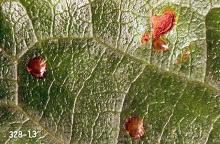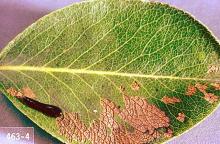Caliroa cerasi
Pest description and crop damage Pear sawfly is a European insect now found in most areas of the U.S. It attacks both pear and cherry and also is found on mountain ash, hawthorn, and ornamental Prunus. The adult is a glossy black wasp, about 0.2 inch long. The larva initially resembles a small slug due to the olive green slime that covers the body, and the fact that the head is wider than the rest of the body. Mature larvae are 0.375 inch long and orange-yellow.
Larvae feed on the upper surface of leaves, skeletonizing them. Heavy feeding causes leaf drop, with reduction in vigor and yield, particularly on young trees.
Biology and life history Pear sawfly overwinters as a pupa in a cocoon 2 to 3 inches deep in the soil. Adults emerge over an extended period in late April-May. The adult female inserts eggs into leaf tissue, and eggs hatch in 10 to 15 days. Larvae immediately begin to feed on the upper surface of the leaf. After 3 to 4 weeks, they drop to the soil to pupate. Second generation adults emerge in July, and larvae from this generation feed in August and September. Most larvae from this generation drop to the ground to overwinter.
Scouting and thresholds Watch trees for the slug-like larvae in August and September when large populations can build up.
Management-cultural control
Individual larvae can be picked off, or they can be washed off with a strong stream of water.
Management-chemical control
See:
Chemical Control of Nursery Pests
For more information
Johnson, W.T. and H.H. Lyon (1991), Insects That Feed on Trees and Shrubs, 2nd ed., Cornell University Press (p. 130).



